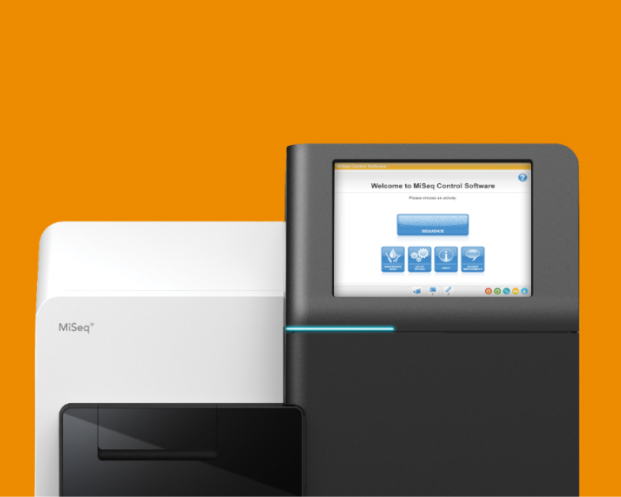| Read length | MiSeq Reagent Nano Kit v2 | MiSeq Reagent Micro Kit v2 | MiSeq Reagent Kit v2 | MiSeq Reagent Kit v3 |
|---|---|---|---|---|
| 1 × 36 bp | N/A | N/A | 540–610 Mb | N/A |
| 2 × 25 bp | N/A | N/A | 750–850 Mb | N/A |
| 2 × 75 bp | N/A | N/A | N/A | 3.3–3.8 Gb |
| 2 × 150 bp | 300 Mb | 1.2 Gb | 4.5–5.1 Gb | N/A |
| 2 × 250 bp | 500 Mb | N/A | 7.5–8.5 Gb | N/A |
| 2 × 300 bp | N/A | N/A | N/A | 13.2–15 Gb |
MiSeq Sequencing System specifications
High performance made simple
Short run times, adjustable read lengths, and multiple flow cell options in one compact benchtop sequencing system

Output per flow cell for various read lengthsa,b
MiSeq Sequencing System
a. The MiSeq System runs a single flow cell. Output per flow cell and output per run are the same.
b. Specifications based on Illumina PhiX control library at supported cluster densities.
Reads passing filter per flow cella
MiSeq Sequencing System
| MiSeq Reagent Nano Kit v2 | MiSeq Reagent Micro Kit v2 | MiSeq Reagent Kit v2 | MiSeq Reagent Kit v3 | |
|---|---|---|---|---|
| Single-end reads | 1M | 4M | 12–15M | 22–25M |
| Paired-end reads | 2M | 8M | 24–30M | 44–50M |
a. Install specifications based on Illumina PhiX control library at supported cluster densities between 865–965 k/mm2 clusters passing filter for v2 chemistry and 1200–1400 k/mm2 clusters passing filter for v3 chemistry. Actual performance parameters may vary based on library type, library quality, and clusters passing filter.
Quality scoresa
MiSeq Sequencing System
| Read length | MiSeq Reagent Kit v2 | MiSeq Reagent Kit v3 |
|---|---|---|
| 2 × 25 bp | > 90% bases higher than Q30 | N/A |
| 2 × 75 bp | N/A | > 85% bases higher than Q30 |
| 2 × 150 bp | > 80% bases higher than Q30 | N/A |
| 2 × 250 bp | > 75% bases higher than Q30 | N/A |
| 2 × 300 bp | N/A | > 70% bases higher than Q30 |
a. The percentage of bases > Q30 is averaged across the entire run.
Run timea
MiSeq Sequencing System
| Read length | MiSeq Reagent Nano Kit v2 | MiSeq Reagent Micro Kit v2 | MiSeq Reagent Kit v2 | MiSeq Reagent Kit v3 |
|---|---|---|---|---|
| 2 × 25 bp | N/A | N/A | ~5.5 hr | N/A |
| 2 × 75 bp | N/A | N/A | N/A | ~21 hr |
| 2 × 150 bp | ~17 hr | ~19 hr | ~24 hr | N/A |
| 2 × 250 bp | ~28 hr | N/A | ~39 hr | N/A |
| 2 × 300 bp | N/A | N/A | N/A | ~56 hr |
a. Total time includes cluster generation, sequencing, and base calling on a MiSeq System enabled with dual surface scanning.
Instrument specifications

MiSeq instrument specifications
-
Light emitting diode (LED)
Wavelengths520 nm, 660 nm
-
Dimensions
W x D x H68.6 cm × 56.5 cm × 52.3 cm
(27.0 in × 22.2 in × 20.6 in) -
Dry weight
57.2 kg (126 lb)
-
Crated weight
93.6 kg (206 lb)
Key technologies
Sequencing by synthesis chemistry
The MiSeq System leverages proven Illumina sequencing by synthesis (SBS) chemistry to deliver accurate data and robust performance. SBS chemistry uses reversible-terminator fluorescently labeled nucleotides to detect single bases as they are incorporated into growing DNA strands, reading billions of sequences in parallel.
The MiSeq System incorporates paired-end sequencing that enables both ends of the DNA fragment to be sequenced. Because the distance between each paired read is known, alignment algorithms can use this information to map the reads. This is especially helpful across difficult-to-sequence, repetitive regions of the genome.